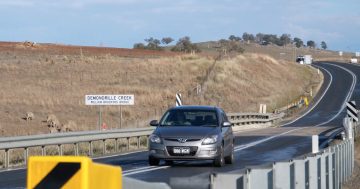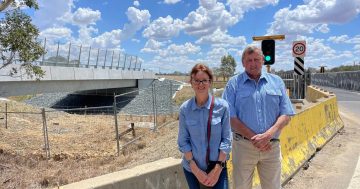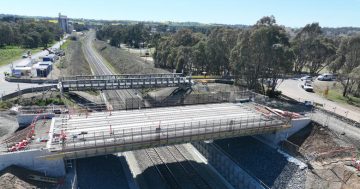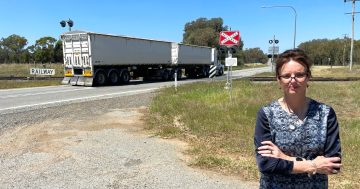
A bus crash at William Bradford Bridge in 2019 resulted in serious injuries to two passengers. Photo: Supplied NSW Ambulance.
Cootamundra MP Steph Cooke’s calls for urgent action on one of the most hazardous bridges in her electorate have prompted a response from the NSW Government, though securing the necessary funding for critical upgrades remains a significant challenge.
Located between Harden-Murrumburrah and Wallendbeen on the Burley Griffin Way, the William Bradford Bridge, built in the early 1930s and reflective of the standards of that time, has been a source of safety concerns for years.
Despite occasional improvements such as upgraded barriers and road signage, the bridge’s narrow lanes have created a pinch point for modern traffic, particularly heavy vehicles, contributing to numerous accidents and near-misses over the years.
But this year, a fatal livestock truck rollover in July and a major multi-vehicle crash in September, proved to be the tipping point for Ms Cooke, who has labelled the bridge one of the most dangerous in the region.
In a recent address to the NSW Parliament, Ms Cooke emphasised William Bradford Bridge’s critical role in connecting rural communities and facilitating freight movement.
“This bridge is more than just infrastructure — it’s a lifeline for families, commuters, travellers and freight operators,” she said, “but its design remains dangerously outdated, and every day we delay increases the risk of further tragedies.”
In response, NSW Minister for Regional Transport and Roads, Jenny Aitchison, this week acknowledged the importance of addressing the safety issues relating to William Bradford Bridge, while also confirming a structural assessment had been completed.
But, the minister stressed, any significant upgrades would have to compete for funding with other regional projects.
Ms Cooke said the minister also confirmed her concerns had been passed on for inclusion in the South East and Tablelands Strategic Regional Integrated Transport Plan (SRITP), a move she welcomed, but she warned the planning process should not be used as an excuse for further delays.
“While planning is important, we cannot let it become an excuse for inaction.
“The community needs action now, not years of studies and consultations,” she said. “Every day this bridge remains a safety risk; lives are at stake.”
Ms Cooke has been supported by local leaders, including the Hilltops Freight Industry Group, in advocating for urgent action to address the bridge’s safety risks since her election in 2017.
“Unfortunately, despite those sustained efforts, Transport for NSW has repeatedly informed me that the bridge, while narrow, is considered compliant under current standards,” she said.
“Compliant or not, the bridge remains a site of frequent accidents and near misses, which speaks to a larger issue of how we define “compliance” versus real-world safety.”
This was illustrated in 2019, when a bus carrying 28 passengers, including children, crashed off the road into a creek bed, leaving a 65-year-old woman in critical condition and an eight-year-old boy with serious fractures.
Though Transport for NSW responded with improvements to barriers, signage, and road delineation, the bridge’s fundamental design flaw – its width — remains a hazard, particularly for freight vehicles and buses.
“We need to widen or replace this bridge to ensure the safety of everyone who relies on this vital route,” Ms Cooke said.
She says her call for urgent action aligns with the NSW Government’s “Towards Zero” initiative, which aims to reduce road fatalities by 50 per cent by 2030 and eliminate road trauma by 2050.
Ms Cooke stressed that achieving these ambitious goals would require targeted investments in high-risk areas like the William Bradford Bridge.
“I acknowledge Minister Aitchison’s public commitment to improving road safety across NSW,” she told parliament. “The Labor Government has made it clear that reducing fatalities on rural roads is a priority, and rightly so. But projects like the William Bradford Bridge are precisely where this commitment must be actioned.
“This is about more than politics — it’s about saving lives,” she said. “We owe it to our communities to act decisively and ensure their safety on our roads.”
Meanwhile, 14 kilometres west of the William Bradford Bridge, work on the new Wallendbeen Bridge is set to be completed by early 2025.
The new two-lane bridge is designed to accommodate larger vehicles and improve traffic flow in the region, replacing a century-old, narrow railway bridge that was closed to traffic due to structural damage in March 2021, as well as a temporary one-lane bridge which was installed in November 2021.
While it is expected to ease some pressure on the Burley Griffin Way, Ms Cooke stresses it is not a replacement for the urgent need to address the safety risks at the William Bradford Bridge.
“The Wallendbeen Bridge is a step forward, but it’s only part of the solution,” Ms Cooke said. “We still need to address the William Bradford Bridge to ensure the safety of everyone who relies on this critical transport route.”
















